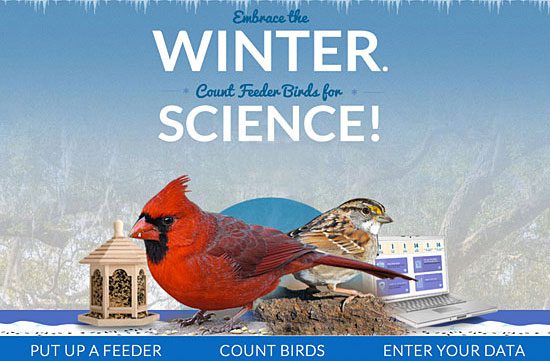Cool New Project FeederWatch Website Launches Ahead of New Season
October 18, 2013
The 2013-2014 Project FeederWatch season begins on November 9. This fun citizen-science project is a great way to turn time spent enjoying your feeder into valuable data that scientists can use to understand bird populations. If you’ve never counted before or if you’re a returning FeederWatcher, you can sign up here.
Project FeederWatch is open to people of all skill levels and backgrounds, including children, families, individuals, classrooms, retirees, youth groups, nature centers, and bird clubs. The seasons run from early November until April each year, and a small participation fee helps to partially cover project expenses and staff support.
Brand new FeederWatch website
To get ready for the new season, we’ve relaunched the Project FeederWatch website. It’s full of beautiful designs and smart features to help you learn, explore, identify, and record and review your counts.
Among the new features:
- A new Photo Upload tool lets you submit photos through our website rather than by email, and it displays them beautifully, too. The tool also allows us to take in entries for our BirdSpotter photo contest (returning for its second year!).
- A new tool called Common Feeder Birds lets you explore which birds are most common in your region of the country and tells you which foods and feeders work best for them.
- Our newly designed Tricky ID pages help give you all the information, side-by-side photos, and tips you need to sort out confusing birds such as accipiters and finches, with more on the way.
Why become a FeederWatcher?
FeederWatch data provide long-term information about bird population biology that cannot be detected by any other available method. When thousands of FeederWatchers in communities across North America count birds and send their tallies to the FeederWatch database, the result is a wealth of data, which FeederWatch scientists analyze to track broad-scale movements of winter bird populations and long-term trends in bird distribution and abundance.
With each season, FeederWatch increases in importance as a unique monitoring tool for more than 100 bird species that winter in North America. To see some of our findings:
- Read Winter Bird Highlights 2013—a summary of last year’s season
- See our illustrated poster: Backyard Birds Open a Window on Science for examples of findings over FeederWatch’s first 25 years.
What does it take to participate?
New participants are sent a Research Kit with complete instructions for participating. You provide the feeder(s) and seed. In addition to the kit, U.S. participants receive a the Cornell Lab’s newsletter, Living Bird News. Canadian participants receive Bird Studies Canada’s quarterly publication, BirdWatch Canada.
There is a $15 annual participation fee for U.S. residents ($12 for Cornell Lab members). Canadians can participate by joining Bird Studies Canada for CAN$35. The participation fee covers materials, staff support, web design, data analysis, and a year-end report (Winter Bird Highlights). Project FeederWatch is supported almost entirely by participation fees. Without the support of our participants, this project wouldn’t be possible—so thank you!

All About Birds
is a free resource
Available for everyone,
funded by donors like you
American Kestrel by Blair Dudeck / Macaulay Library